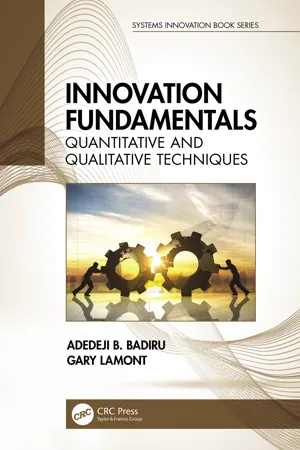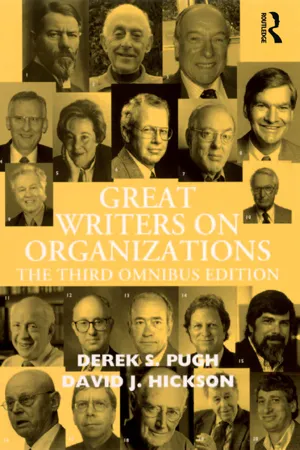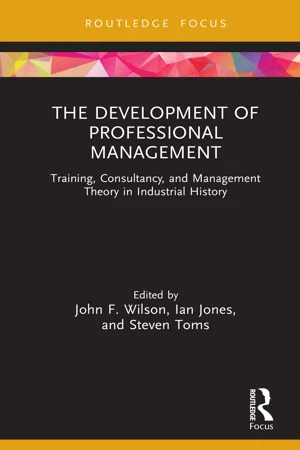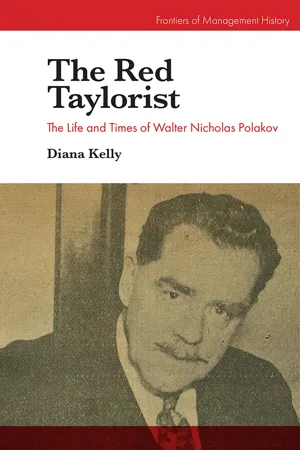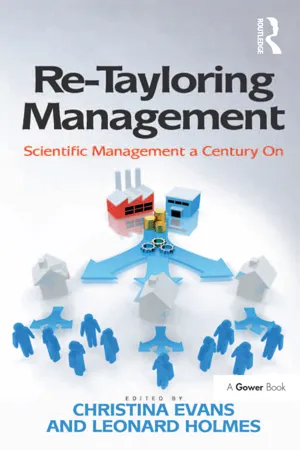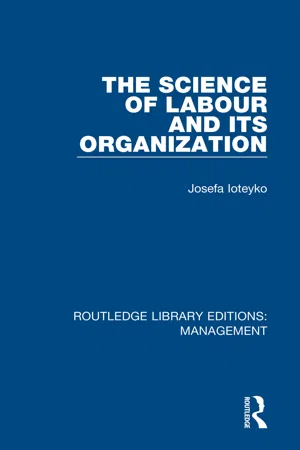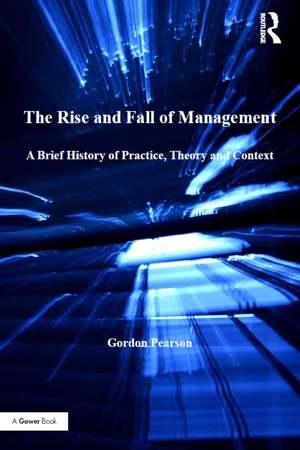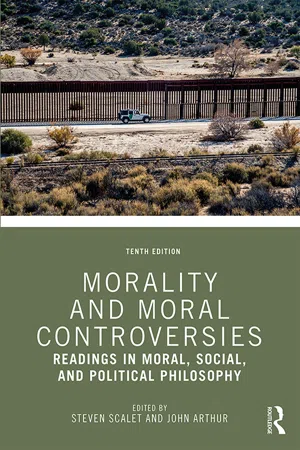Technology & Engineering
Frederick Winslow Taylor
Frederick Winslow Taylor was an influential figure in the field of management and engineering. He is best known for his development of scientific management, which emphasized the application of scientific methods to optimize productivity and efficiency in the workplace. Taylor's work laid the foundation for modern management practices and had a significant impact on the fields of technology and engineering.
Written by Perlego with AI-assistance
Related key terms
Related key terms
1 of 4
Related key terms
1 of 3
12 Key excerpts on "Frederick Winslow Taylor"
- eBook - ePub
London's Global Office Economy
From Clerical Factory to Digital Hub
- Rob Harris(Author)
- 2021(Publication Date)
- Routledge(Publisher)
Frederick Winslow Taylor (1856–1915) was born in Germantown, Philadelphia, into a wealthy, highly educated and liberal-minded Quaker family. His father was a lawyer and graduate of Princeton, and his mother an abolitionist and feminist. Following a three-year ‘Grand Tour’ of Europe, Frederick enrolled into the highly respected Phillips Exeter Academy in New Hampshire. However, his health was poor, and despite passing the Harvard entrance examination, he left Exeter prematurely. After several months of recuperation, and in his 18th year, he chose a vocation in engineering, joining Ferrell and Jones (later the Enterprise Hydraulic Works). Despite his social background and obvious intellectual strengths, Taylor followed the pure and principled nature of his upbringing and started his new vocation as a humble pattern maker’s apprentice. On completing his apprenticeship in 1878, Frederick moved to the Midvale Steel Company to take a post as a machinist.His inquisitive and innovative mind soon marked him out for greater things, and he scaled the corporate ladder rapidly, rising to research director and then chief engineer. His dedication was to be demonstrated by his ability to earn an engineering degree from the Stevens Institute of Technology in New Jersey, at the age of 25, while working full-time. Taylor was an innovator and a rationalist, and he was imbued with a belief in the role of science and technology in the advancement of mankind.Figure 8.1 Frederick Winslow TaylorWhile at Midvale, Taylor studied industrial productivity and methods for measuring output. He introduced piecework, developing detailed systems aimed at maximising the efficiency of men and machines in the factory. His work involved time and motion studies to determine the best methods for performing tasks in the least amount of time. His basic thesis was that incentive-based wages were ineffective unless they were used alongside carefully planned and managed tasks, backed up by supportive and co-operative management. He argued for the careful selection and development of people, identifying clear goals and tasks, organising feedback, providing training and encouraging group support. His methods were successful and output rose significantly. Scientific management was born.Taylor became a consulting engineer at the age of 37, often making enemies in the companies where his methods resulted in job losses aimed at increasing efficiency. His most important client became the Bethlehem Iron Company, but following various disputes with the management, he was fired in 1901. This was to be his last job. His most famous published work, The Principles of Scientific Management,1 - eBook - ePub
- Morgen Witzel(Author)
- 2016(Publication Date)
- Routledge(Publisher)
13 But there was more to it even than this. Management also had to examine itself, its own role and function, and try to come up with a set of guiding principles. That is the task which was attempted by Frederick Winslow Taylor.Taylor and his ideas
Taylor is one of the most widely discussed, and probably one of the most widely vilified, figures in the history of management thought. His critics are legion, and though some like biographer Robert Kanigel are harsh but fair, others have had a tendency to criticise what they thought Taylor said, rather than what he actually said.14 I do not intend to go into Taylor’s ideas in detail here, but hopefully by referring back to Taylor himself rather than to his numerous critics, we can make his position and ideas clear.Born in 1856 into a Quaker family, Taylor had a good education, which included several years spent in Europe. He was intended to go to Harvard University, but then for reasons that are not entirely clear he chose to apprentice as a machinist instead (conventional wisdom has it that he suffered bouts of ill-health, including headaches, which prevented him studying, but the work of a machinist hardly seems suitable for someone in that condition). After his apprenticeship Taylor took a job at the Midvale Steel Works in Philadelphia.15 He was promoted to foreman and then to chief engineer, and also took a degree in mechanical engineering from the Stevens Institute of Technology. He thus acquired a high degree of technical knowledge, both theoretical and practical. During his time at Midvale, as he tells us in his later writings, he began to consider the problem described by Towne in his paper in 1886. Taylor left Midvale in 1900 and had several jobs thereafter before setting up his own engineering consultancy, and it was not until 1895 that he had leisure to organise his thoughts and present his own paper, ‘A Piece-Rate System’, to the American Society of Mechanical Engineers.16 - eBook - ePub
Innovation Fundamentals
Quantitative and Qualitative Techniques
- Adedeji B. Badiru, Gary Lamont(Authors)
- 2021(Publication Date)
- CRC Press(Publisher)
Frederick Winslow Taylor (1856–1915) was born in the Germantown section of Philadelphia to a well-to-do family. At the age of 18, he entered the labor force, having abandoned his admission to Harvard University due to an impaired vision. He became an apprentice machinist and pattern-maker in a local machine shop. In 1878, when he was 22, he went to work at the Midvale Steel Works. The economy was in a depressed state at the time. Frederick was employed as a laborer. His superior intellect was very quickly recognized. He was soon advanced to the positions of time clerk, journeyman, lathe operator, gang boss, and foreman of the machine shop. By the age of 31, he was made chief engineer of the company. He attended night school and earned a degree in mechanical engineering in 1883 from Stevens Institute. As a work leader, Taylor faced the following common questions:Which is the best way to do this job? What should constitute a day's work?These are still questions faced by the industrial engineers of today. Taylor set about the task of finding the proper method for doing a given piece of work, instructing the worker in following the method, maintaining standard conditions surrounding the work so that the task could be properly accomplished, and setting a definite time standard and payment of extra wages for doing the task as specified. Taylor later documented his industry management techniques in his book entitled The Principles of Scientific Management. This is, indeed, industrial engineering!The work of Frank and Lillian Gilbreth coincided with the work of Frederick Taylor. In 1895, on his first day on the job as a bricklayer, Frank Gilbreth noticed that the worker assigned to teach him how to lay brick did his work three different ways. The bricklayer was insulted when Frank tried to tell him of his work inconsistencies – when training someone on the job, when performing the job himself, and when speeding up. Frank thought it was essential to find one best way to do work. Many of Frank Gilbreth's ideas were similar to Taylor's ideas. However, Gilbreth outlined procedures for analyzing each step of work flow. Gilbreth made it possible to apply science more precisely in the analysis and design of the work place. Developing therbligs - eBook - ePub
Great Writers on Organizations
The Third Omnibus Edition
- Derek S. Pugh, David J. Hickson(Authors)
- 2016(Publication Date)
- Routledge(Publisher)
Henri Fayol puts forward a classic analysis of the management task, based on his long practical experience of doing the job and the personal insights he gained. Lyndall Urwick and Edward Brech have over many years collated and expounded general principles of administration, aiming at a unified body of knowledge. Frederick Taylor’s name is synonymous with the term ‘scientific management’. His extremely influential ideas made him a controversial figure in his own day and have remained a subject for much argument. Harry Braverman mounts a critique, from a Marxist perspective, of the degradation which Taylor’s ideas bring to modern work.Mary Parker Follett’s emphasis is on the ‘law of the situation’ which presents its own solutions if people will only look beyond the interplay of personalities. Peter Drucker emphasizes the necessity of ‘management by objectives’ if high performance is to be achieved.Alfred P. Sloan, drawing on his experience as the head of one of the largest corporations in the world, is concerned with establishing the management framework within which objectives are established and decisions made. Thomas Peters and Robert Waterman, in an influential analysis, report a set of eight attributes which characterize excellent firms and propose that they should be widely adopted. William Ouchi asks what management lessons the West can learn from Japanese companies and suggests adaptations which can be beneficially applied. Rosabeth Moss Kanter proposes ways in which organizations should be managed to draw more fully on the total human resources within them. Karl E. Weick points to the way in which each individual’s subjective attempts to make sense of the organization must be understood and taken into account in the management process.Henri Fayol
Henri Fayol (1841–1925) was a mining engineer by training. A Frenchman, he spent his working life with the French mining and metallurgical combine Commentry-Fourchamboult-Decazeville, first as an engineer but from his early thirties onwards in general management. From 1888 to 1918 he was Managing Director. - eBook - ePub
- Bernard P. Cronin(Author)
- 2019(Publication Date)
- Routledge(Publisher)
The break up of craft skills and the reconstruction of production ... have destroyed the traditional concept of skill and opened up only one way for mastery over labour processes to develop; in and through scientific, technical and engineering knowledge. But the extreme concentration of this knowledge in the hands of management... has closed this avenue to the working population ... (1974: 443).The question as to how it was possible for management to appropriate artisans' skills within a 'science of management' in the way he suggested can only be answered within the context of Taylor's innovatory technologies and the advances in metrology and precision measurement. Taylor's major contribution to an employers' ideology of production lay not in 'scientific management' per se, but in bringing the pioneering work on workshop practices of engineer-entrepreneurs such as Maudslay, Whitworth and Nasmyth in the 18th and early 19th centuries into contemporary engineering practice.The technologies developed and implemented by these British engineers in particular were designed to operate in a specific set of social relations within which the worker had minimal autonomy; the technologies were factors of labour control. This characterisation is not new, but serves to stress that the indispensable condition for the radical restructuring of control of work undertaken by Taylor was as much a technological as a management imperative. The machines were not technologies requiring new forms of skilled expertise but were designed, from the outset, for use of unskilled or raw labour (Nasmyth 1856; Whitworth 1854, 1856; Taylor 1911a; Hoxie 1918; Littler 1980, 1985). A recent study expresses a common perspective of this process as a 'zero-sum' situation: 'all work which management succeeded in bringing to the surface - that is brought under control - fell from the workers' control ... ' (Bonazzi 1994: 288). The common assumption here is that the technology originally had been under the control of workers. The pioneering work of Taylor and the earlier British engineers was premised upon the employment of raw labour for which no antecedent skills were assumed or expected. - eBook - ePub
The Development of Professional Management
Training, Consultancy, and Management Theory in Industrial History
- John F. Wilson, Ian Jones, Steven Toms, John F. Wilson, Ian Jones, Steven Toms(Authors)
- 2021(Publication Date)
- Routledge(Publisher)
Kanigel 1997, Nadworny, 1955). Even recent publications on the history of management have shown the limits of effectiveness of their scholarship when authors base their ideas on the a priori assumption that the system of scientific management. . . was based upon breaking a job down into its constituent elements. Unnecessary motions were dispensed with and each element was timed by means of a stop- watch. 3 As the originator of scientific management, Frederick Winslow Taylor argued in the face of similar assertions, the traditional managerialist reasoning confuses the tools for the essence or philosophy. 4 The narrow process of defining and ‘examining’ scientific management has been reversed in the last decade or so as Taylorism has been revisited by a number of scholars who have investigated scientific management unencumbered by these kinds of value-laden a priori assumptions. 5 Drawing most notably on the original material of the Taylorists in the Taylor Society, 6 these scholars have shown that the Taylorists can be marked off from what they called the cheap shams and ‘stunt peddlers’. Moreover, close analysis of Taylor Society documents and the writings of Taylorists such as Morris Cooke and Harlow Person show how different the committed Taylorists were from those kinds of capitalists particularly favoured by the movement’s detractors (and most modern textbook writers in business and social sciences). Many designated themselves scientific managers, but then invoked only a few ‘shortcuts’, rather than the whole method or philosophy. A commitment to the whole philosophy of scientific management is most clearly apparent in the Taylor Society, founded by those who knew Frederick Taylor and sought to emulate his philosophy and implement his ideas in toto. Taylor Society members reserved their strongest language for those who operated thus in the name of scientific management - eBook - ePub
The Red Taylorist
The Life and Times of Walter Nicholas Polakov
- Diana Kelly(Author)
- 2020(Publication Date)
- Emerald Publishing Limited(Publisher)
Too often we management historians, if I may claim thus, assume everyone knows what is and was scientific management, and what has been its importance. The term “scientific management” which is largely interchangeable with “Taylorism,” refers to an ideology first given form by Frederick Winslow Taylor, polymath, scientist, and management idealist, implementing his ideals in paper mills and steel plants (Midvale and Bethlehem Steel) in the late nineteenth century. Taylor sought to use research, planning, and evaluating practices in the workplace, in order to improve productivity and move production and planning decisions away from whimsy and rule-of-thumb that predominated. From the early twentieth century, Taylor worked as consultant and adviser to his growing band of followers. Baldly put, Taylor, who titled his 1911 book using the new term, “scientific management,” promoted the use of scientific investigation and planning in the management of work and production. Beyond these data, much else has been subject to interpretation and varieties of emphases but the centrality of science and planning was fundamental at workplace, organisation and well beyond.Some who had first worked with Taylor on the shopfloor, such as Gantt, also had numerous followers. Thus by the time the Society to Promote the Science of in Management was formed in 1912, there was a strong core of experienced and knowledgeable members. This Society was the centre of scientific management or Taylorism. It was under the guidance of the founding 30 members, most of whom were engineers, and some of whom remained in senior roles in the TS for another 20 or 30 years. They included Morris Llewellyn Cooke, Charles Day, Horace King Hathaway and Harlow Person. These Taylorists worked in public and private sector organisations and industries, investigating inputs and outputs of firms, and organising production and work. Like their original “founder,” Taylor, they had strong ideas about the importance of planning and a scientific approach to, as well as aspirations for, cooperative and committed workers. They believed in the democracy that came with management through science, as against assumptions of inherent managerial prerogative with its assumptions of hierarchy and its seeming capriciousness.The term “scientific management” is said to have been first mooted by lawyer, Louis Brandeis in the preparations for the Eastern Rates case of 1910 (Drury, 1915). This was to be a landmark legal case on increasing railway charges. What Brandeis argued on advice from Harrington Emerson and the Taylorists, was that rate rises were unnecessary because the costs of running the major railway company could be reduced by managing through implementation of efficiency engineering or the principles of “scientific management” (Duffy, 2003). - eBook - ePub
Re-Tayloring Management
Scientific Management a Century On
- Leonard Holmes, Christina Evans, Christina Evans(Authors)
- 2016(Publication Date)
- Routledge(Publisher)
This experience and his subsequent work as a freelance consulting engineer between 1890 and 1898 and as a manager at the Bethlehem Steel Works between 1898 and 1900 provided the raw material for his first paper on piece rate systems and his first book, Shop Management (Taylor 1895, 1904). In 1901, Taylor set up as a consultant again, and over the next fourteen years he and his associates introduced 'scientific management' in 181 factories and other large commercial organizations (Nelson 1992). Over this period, Taylor and his colleagues developed and described the practices which would become known as 'shop management' and then 'scientific management' and ultimately 'Taylorism'. Members of Taylor's entourage and the growing scientific management movement included industrialists like James Dodge, as well as the consultants Carl Barth, Morris Cooke, Frank Gilbreth, H.K. Hathaway, Robert Kent, Conrad Lauer and Dwight Merrick (Urwick 1949). Many of these individuals, like Taylor, had served apprenticeships and worked their way up into management positions within one or more companies, many of them aided by subsequent study at one of the growing number of universities and colleges. The experiences of these individuals in large industrial concerns formed the basis for the talks, papers and books that they produced. This combination of a number of colleagues writing up established practice, developing new ways of working and consulting with other companies meant that Taylorism had many sources and contributors. As Lyndall Urwick, the most influential champion of Taylorism in the UK, commented in the late 1940s: 'scientific management' [Taylorism] was not an invention, a new idea which occurred suddenly to the fertile brains of F.W. Taylor and his colleagues. It was merely the codification and restatement in coherent and logical form of the essence of a host of practices which had been developing in the best managed factories over a very long period - eBook - ePub
Marketing Skills in Practice
Developing a Successful Marketing Career
- Linda Anne Barkas, Yvonne Dixon-Todd(Authors)
- 2023(Publication Date)
- Routledge(Publisher)
The management process is described by Witzel (2022, p. 1) as ‘the coordination and direction of activities of oneself and others towards some particular end’. The management process may sound simple, but it is an exceedingly complex process that has been studied for many years. Early studies on improving processes started in engineering in the early twentieth century with research called ‘ scientific management’, such as Frederick Taylor’s seminal work The Principles of Scientific Management (1947). He was the first to really study the nature of work (Drucker, 1974). Frederick Winslow Taylor was an American Quaker engineer who invented scientific management, which was the foundation of later work in time and motion studies. He began work as a labourer in the steel industry, progressing to chief engineer, whereby he started breaking down tasks into small sections, utilising a stopwatch to see how long things took and whether or not, with various adjustments, tasks could be done more efficiently. His study ‘ scientific management’ was the forerunner to time and motion studies developed by Frank and Lillian Gilbreth (1917). In the early 1900s, Henry Ford also applied standardised processes to the assembly line at the Ford Motor plant (Jenson, 1989). This has become known as ‘ Fordism’ as a management style, a term used by several management theorists. While effective results were demonstrated, the impact was not so good on people, as the tasks were repetitive, with a lack of human interaction - eBook - ePub
- Josefa Ioteyko(Author)
- 2018(Publication Date)
- Routledge(Publisher)
Hence the necessity for having an office for the especial study of the best methods of working. These methods should be known to the men. Therefore, it is also necessary to have another office for the training of overseers capable of guaranteeing this desideratum. F. W. Taylor (born in 1856, died in 1915), was descended from a Philadelphia family; he was, by turns, apprentice, labourer, master mechanic, then director of a training college, and finally, in 1884, Chief Engineer of the Midvale factories. He took his diploma at the Stevens Institute of Technology. In 1890, he left the Midvale steelworks to become General Director of the Manufacturing Investment Company which manufactured mills for the great chemical industries. He left this Company in 1893, and dedicated the whole of his time to the introduction of his system of organisation into various industries. F. W. Taylor, says M. Le Châtelier, was not only a genius, but he was a man of a noble nature, faithful to his friends, devoted to the public good, and in great sympathy with the aspirations of the working classes. Since Taylor’s death, an International Committee has been formed for continuing the struggle on behalf of the American engineer’s ideas. The active members of the committee are: Mr. Carl Barth, consulting engineer; Mr. Norris Cooke, director of public works in the city of Philadelphia; Mr. Dodge, president of the Link Belt Co. of Philadelphia, whose factories are entirely reorganised on Taylor’s plans; Mr. Hathaway, director of the Tabor Manufacturing Co., Philadelphia; one of the first factories to adopt Taylor’s methods, and where those engineers, who go to the United States to study Taylor’s system, are sent. The secretary of the committee is Miss Frances Mitchell, Boxly, Highland Station, Chestnut Hill, Philadelphia, U.S. Let us now examine Taylor’s system closely, basing our enquiries on those of M. Le Châtelier - eBook - ePub
The Rise and Fall of Management
A Brief History of Practice, Theory and Context
- Gordon Pearson(Author)
- 2016(Publication Date)
- Routledge(Publisher)
The employer–employee relationship was always an important part of management’s responsibility. The potential for the strong employer to exploit the weak worker was apparent from the start of industrialization. Marx’s reference to the ‘negotiation’ between the labourer and ‘Mr Moneybags’, after which the latter was ‘smirking’ his satisfaction at the outcome, was theoretical rather than based on personal experience. It did not include any report on the actual negotiation, the act of stealing the surplus earned by the worker. Fred Taylor had no such qualms. His account was based on personal participation.Scientific Management
The application of ‘science’ to management was timely as it coincided with the blossoming of various branches of natural science and scientific discovery and it was attractive since it appeared to depersonalize the potentially explosive employer–employee relationship. Taylor, a devoted Quaker, was focused on how to bring management and labour together in productive partnership from which both should gain.Kanigel’s biography of Taylor describes him as:‘… the first efficiency expert, the original time-and-motion man. To organized labour, he was the soulless slave driver, out to destroy the workingman’s health and rob him of his manhood. To the bosses, he was an eccentric and a radical, raising the wages of common labourers by a third, paying college boys to click stopwatches. To him and his friends, he was a misunderstood visionary, possessor of the one best way that, under the banner of science, would confer prosperity on worker and boss alike, abolishing the ancient class hatreds.’33 Kanigel, R., (1997 ), The One Best Way: Frederick Winslow Taylor and the Enigma of Efficiency, London: Little, Brown & Company, p. 1.Taylorism, or scientific management, was concerned first and foremost with how business could survive, rather than with how to divide the spoils of industry. Taylor himself claimed that resolving the power struggle was the end to which efficiency was the means, not the other way round. - eBook - ePub
Morality and Moral Controversies
Readings in Moral, Social, and Political Philosophy
- Steven Scalet, John Arthur, Steven Scalet, John Arthur(Authors)
- 2019(Publication Date)
- Routledge(Publisher)
Taylor’s tight industrial choreography—his “system,” as he liked to call it—was embraced by manufacturers throughout the country and, in time, around the world. Seeking maximum speed, maximum efficiency, and maximum output, factory owners used time-and-motion studies to organize their work and configure the jobs of their workers. The goal, as Taylor defined it in his celebrated 1911 treatise, The Principles of Scientific Management, was to identify and adopt, for every job, the “one best method” of work and thereby to effect “the gradual substitution of science for rule of thumb throughout the mechanic arts.” Once his system was applied to all acts of manual labor, Taylor assured his followers, it would bring about a restructuring not only of industry but of society, creating a utopia of perfect efficiency. “In the past the man has been first,” he declared; “in the future the system must be first.” Taylor’s system is still very much with us; it remains the ethic of industrial manufacturing. And now, thanks to the growing power that computer engineers and software coders wield over our intellectual lives, Taylor’s ethic is beginning to govern the realm of the mind as well. The Internet is a machine designed for the efficient and automated collection, transmission, and manipulation of information, and its legions of programmers are intent on finding the “one best method”—the perfect algorithm—to carry out every mental movement of what we’ve come to describe as “knowledge work.” Google’s headquarters, in Mountain View, California—the Googleplex—is the Internet’s high church, and the religion practiced inside its walls is Taylorism. Google, says its chief executive, Eric Schmidt, is “a company that’s founded around the science of measurement,” and it is striving to “systematize everything” it does
Index pages curate the most relevant extracts from our library of academic textbooks. They’ve been created using an in-house natural language model (NLM), each adding context and meaning to key research topics.
Explore more topic indexes
Explore more topic indexes
1 of 6
Explore more topic indexes
1 of 4


